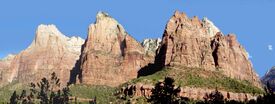
Massive cliffs in Zion Canyon consist of Lower Jurassic formations, including (from bottom to top): the Wingate Sandstone, the Kayenta Formation, and the massive Navajo Sandstone.
The Early Jurassic (in geology referred to as the Lower Jurassic, originally (and still in Europe) the "Lias") is the earliest of three epochs of the Jurassic period.
Outcrops
There are extensive Liassic outcrops around the coast of the UK, in particular in Dorset, often associated with the pioneering work of Mary Anning of Lyme Regis. The facies of the Lower Jurassic in this area are predominantly of clays, thin limestones and siltstones, deposited under fully marine conditions.
Perhaps the best example of a liassic coastline in the world are the superb cliffs of the Vale of Glamorgan in southern Wales. Stretching for around 14 miles just outside Cardiff, the remarkable strata of the cliffs, situated on the Bristol Channel are a mixture of carboniferous sandstone/limestone, shale and liassic limestone, created during a geological upheaval known as the variscan orogeny.
Stratigraphy
There has been some debate over the actual base of the Hettangian Stage, and so of the Jurassic system itself. Biostratigraphically, the first appearance of psiloceratid ammonites has been used; but this depends on relatively complete ammonite faunas being present, a problem that makes correlation between sections in different parts of the world difficult. If this biostratigraphical indicator is used, then technically the Lias Group — a lithostratigraphical division — spans the Jurassic / Triassic boundary.
Life
Ammonites
During this period, ammonoids, which had almost died out at the end-of-Triassic extinction, radiated out into a huge diversity of new forms with complex suture patterns (the ammonites proper). Ammonites evolved so rapidly, and their shells are so often preserved, that they serve as important zone fossils. There were several distinct waves of ammonite evolution in Europe alone (see e.g. Davies, 1920, pp.173-5)
Marine Reptiles
The Early Jurassic was an important time in the evolution of the marine reptiles. The Hettangian saw the already existing Rhaetian ichthyosaurs and plesiosaurs continuing to flourish, while at the same time a number of new types of these marine reptiles appeared, such as Ichthyosaurus and Temnodontosaurus among the ichthyosaurs, and Eurycleidus, Macroplata, and Rhomaleosaurus among the plesiosaurs (all Rhomaleosauridae, although as currently defined this group is probably paraphyletic). All these plesiosaurs had medium-sized necks and large heads. In the Toarcian, at the end of the Early Jurassic, the thalattosaurs or marine Crocodiles appear, as do new genera of ichthyosaurs (Stenopterygius, Eurhinosaurus, and the persistently primitive Suevoleviathan) and plesiosaurs (the elasmosaurs (long-necked) Microcleidus and Occitanosaurus, and the pliosaur Hauffiosaurus).
Terrestrial animals
On land, a number of new types of dinosaurs - the heterodontosaurs, scelidosaurs, stegosaurs, and tetanurae, appeared, and joined those groups like the podokesaurs, prosauropods and the sauropods that had continued over from the Triassic. Accompanying them as small carnivores were the sphenosuchid and protosuchid crocodilians. In the air, new types of pterosaurs replaced those that had died out at the end of the Triassic. While in the undergrowth were various types of early mammals, as well as tritylodont mammal-like reptiles, lizard-like sphenodonts, and early Lissamphibians.
Origin of the name Lias
There are two possible reasons for the name Lias: the first reason is it was taken by a geologist from an English quarryman's dialect pronunciation of the word "layers"; secondly, sloops from North Cornwall ports such as Bude would sail to the Vale of Glamorgan heritage coast to load up on lias limestone (lias limestone from South Wales was used throughout North Devon/North Cornwall as it contains calcium carbonate to fertilise the poor quality Devonian soils of the West Country); the Cornish would pronounce the layers of limestone as 'laiyers' or 'lias'.
References
- Davies, A. M., An Introduction to Palaeontology, Thomas Murby & Co., London
- House, M.R. (1993) Geology of The Dorset Coast, The Geologists' Association.
- Simms, M.J.,Chidlaw, N., Morton, N. and Page, K.N.(2004) British Lower Jurassic Stratigraphy, Geological Conservation Review Series, No.30, Joint Nature Conservation Committee, Peterborough.
External links
- Early Jurassic Period - The Lias epoch - Palaeos - overall presentation
- Lecture 12 - Early Jurassic - informative lecture notes by Dr Paul Olsen
| Jurassic period | ||
|---|---|---|
| Lower/Early Jurassic | Middle Jurassic | Upper/Late Jurassic |
| Hettangian | Sinemurian Pliensbachian | Toarcian |
Aalenian | Bajocian Bathonian | Callovian |
Oxfordian | Kimmeridgian Tithonian |